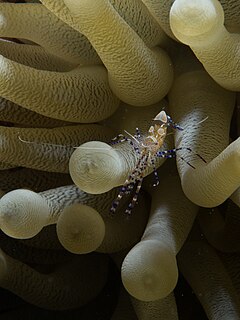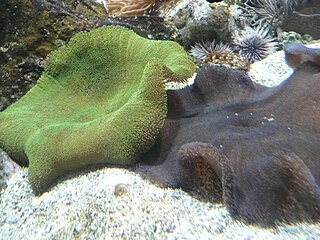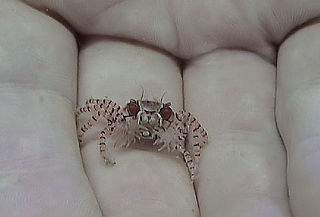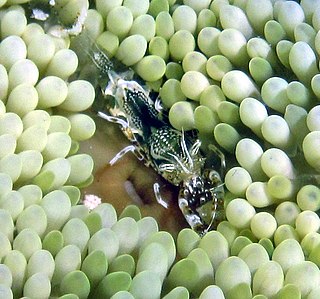
Anthozoa is a class of marine invertebrates which includes the sea anemones, stony corals and soft corals. Adult anthozoans are almost all attached to the seabed, while their larvae can disperse as part of the plankton. The basic unit of the adult is the polyp; this consists of a cylindrical column topped by a disc with a central mouth surrounded by tentacles. Sea anemones are mostly solitary, but the majority of corals are colonial, being formed by the budding of new polyps from an original, founding individual. Colonies are strengthened by calcium carbonate and other materials and take various massive, plate-like, bushy or leafy forms.

The spotted cleaner shrimp, is a kind of cleaner shrimp common to the Caribbean Sea. These shrimp live among the tentacles of several species of sea anemones. They sway their body and wave their antennae in order to attract fish from which they eat dead tissue, algae and parasites.

Stenorhynchus seticornis, the yellowline arrow crab or simply arrow crab, is a species of marine crab.

Stichodactyla haddoni, commonly known as Haddon's sea anemone, is a species of sea anemone belonging to the family Stichodactylidae. It is found in the Indo-Pacific area.

Thor amboinensis, commonly known as the squat shrimp or sexy shrimp, is a species of shrimp found across the Indo-West Pacific and in parts of the Atlantic Ocean. It lives symbiotically on corals, sea anemones and other marine invertebrates in shallow reef communities.

Mithraculus sculptus, the green clinging crab or emerald crab, is a species of crab in the family Majidae. It is a dark green colour and is found in tropical waters in the Caribbean Sea. It is sometimes kept in reef aquaria.

Sea anemones are the marine, predatory animals of the order Actiniaria. They are named after the anemone, a terrestrial flowering plant, because of the colourful appearance of many. Sea anemones are classified in the phylum Cnidaria, class Anthozoa, subclass Hexacorallia. As cnidarians, sea anemones are related to corals, jellyfish, tube-dwelling anemones, and Hydra. Unlike jellyfish, sea anemones do not have a medusa stage in their life cycle.

Condylactis gigantea is a tropical species of ball anemone that is found in shallow reefs and other shallow inshore areas in the Caribbean Sea – more specifically the West Indies – and the western Atlantic Ocean including southern Florida through the Florida Keys. It is also commonly known as: giant Caribbean sea anemone, giant golden anemone, condylactis anemone, Haitian anemone, pink-tipped anemone, purple-tipped anemone, and Florida condy. This species can easily be seen growing in lagoons or in inner reefs as either individuals or loose groups, but never as colonies. They are often used as a model organism along with others in their genus for facultative symbiosis with monocellular algae.

Stichodactyla helianthus, commonly known as sun anemone, is a sea anemone of the family Stichodactylidae. Helianthus stems from the Greek words ἡλιος, and ἀνθος, meaning flower. S. helianthus is a large, green, sessile, carpet-like sea anemone, from the Caribbean. It lives in shallow areas with mild to strong currents.

Epiactis prolifera, the brooding, proliferating or small green anemone, is a species of marine invertebrate in the family Actiniidae. It is found in the north-eastern Pacific. It has a feature rare among animals in that all individuals start life as females but develop testes later in their lives to become hermaphrodites.

Triactis is a genus of sea anemone in the family Aliciidae. It is monotypic, having only one species – Triactis producta. This is found in shallow waters in the Indo-Pacific where it lives on the seabed, rocks and corals. It derives much of its energy needs from the symbiotic algae it contains. It also forms a mutualistic relationship with small Lybia crabs.

Ancylomenes pedersoni, sometimes known as Pederson's shrimp, is a species of cleaner shrimp. It is part of the genus Ancylomenes and was described in 1958 by Fenner A. Chace Jr. as Periclimenes pedersoni. Ancylomenes pedersoni is found in the Caribbean Sea, often associated with a sea anemone, at depths of 1 to 15 metres. They are often found on the reefs off Bermuda.

Bartholomea annulata is a species of sea anemone in the family Aiptasiidae, commonly known as the ringed anemone or corkscrew anemone. It is one of the most common anemones found on reefs in the Caribbean Sea.
Mithraculus cinctimanus is a species of crab in the family Majidae. It is found in the Caribbean region and is usually associated with a sea anemone, sponge or coral.

Phyllodiscus is a monotypic genus of sea anemones in the family Aliciidae. The only species is Phyllodiscus semoni, commonly known as the night anemone, which is native to shallow seas in the central Indo-West Pacific, such as Indonesia, the Philippines and southern Japan. It is venomous and can cause a painful, long-lasting sting to humans. It is called unbachi-isoginchaku in Japanese which translates as "wasp-sea anemone".

Lebrunia coralligens, commonly known as the hidden anemone, is a species of sea anemone in the family Aliciidae. It is found in shallow water in the Bahamas, the Caribbean, and Brazil. It lives in fissures in corals and rocks.

Condylactis aurantiaca, commonly known as the golden anemone, is a species of sea anemone in the family Actiniidae. This species always remains largely buried in sand or sediment, attached to the substrate, with only the oral disc and tentacles visible.

Periclimenes rathbunae is a species of shrimp in the family Palaemonidae, also known as the sun anemone shrimp. It is found in the Caribbean Sea, the Gulf of Mexico, Florida and the Bahamas. It was first described by American biologist Waldo LaSalle Schmitt in 1924 and named in honor of American zoologist Mary J. Rathbun. This shrimp is usually found living in association with the sea anemone Stichodactyla helianthus or occasionally with Condylactis gigantea.

Exaiptasia is a genus of sea anemone in the family Aiptasiidae, native to shallow waters in the temperate western Atlantic Ocean, the Caribbean Sea and the Gulf of Mexico. It is monotypic with a single species, Exaiptasia pallida, and commonly known as the brown anemone, glass anemone, pale anemome, or simply as Aiptasia.

Cinetorhynchus rigens is a species of shrimp in the family Rhynchocinetidae. Common names include mechanical shrimp, Atlantic dancing shrimp, red night shrimp and red coral shrimp. It occurs in shallow water in the tropical Atlantic Ocean.



















